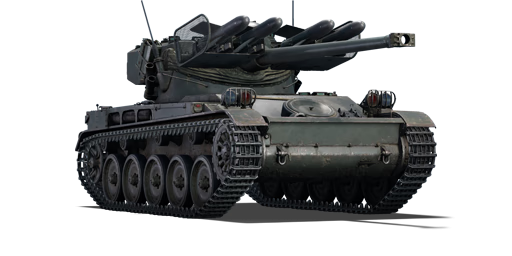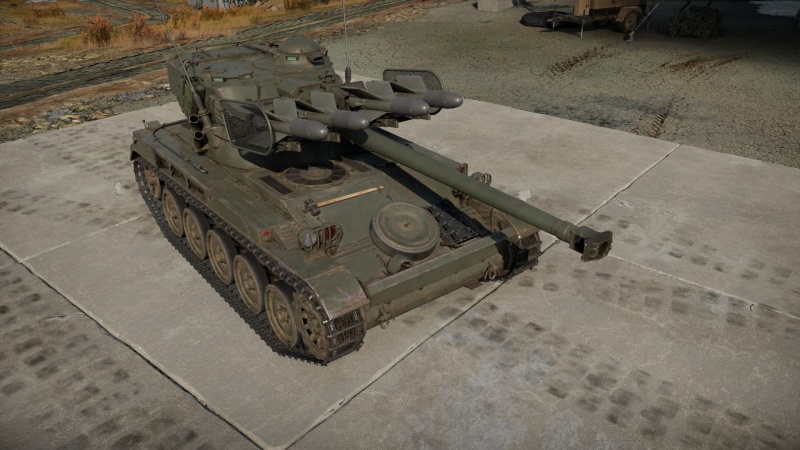AMX-13 (SS.11)
| This page is about the French light tank AMX-13 (SS.11). For other versions, see AMX-13 (Family). |
Contents
Description
The AMX-13/75 FL-10 (Char Lance SS.11) is the third subvariant of the AMX-13/75 FL-10, which is the first variant of the AMX-13 light tank family. It is identical to the standard AMX-13/75 FL-10, except for the four SS.11 anti-tank guided missiles (ATGMs) mounted on a launcher above the main armament. Nord Aviation's SS.11 is a French manual command to line-of-sight wire-guided ATGM. It was one of the first ATGMs, entering service with the French Army in 1956 and serving until the 1980s. It also served as the foundation for the larger and more powerful SS.12/AS.12 series. The missile was manually guided by comparing the location of the target to flares on the back of the missile and adjusting its flight with a small joystick.
Introduced in Update 1.75 "La Résistance", the AMX-13/75 FL-10 (Char Lance SS.11) has the same playstyle as the standard AMX-13/75 FL-10. This light tank is extremely fast and agile, but it sacrifices its armour to do so. As a result of this, the AMX-13/75 FL-10 (Char Lance SS.11) is best used as a hit-and-run flanking vehicle or a sniper, especially with the SS.11 ATGMs onboard. Position the tank quickly at the start of the battle in regions where enemy tanks would not expect to see a light tank and wait in ambush for hostile tanks to pass through. This light tank with an autoloader is capable of effortlessly annihilating multiple opponents. When the enemy is far away or heavily armoured, use the SS.11 missiles. Avoid going to the front lines where the major battle is going on. Stay as close to the corner as possible, only driving out to attack an enemy who is not paying attention.
General info
Survivability and armour
The AMX-13 SS.11 is quite a typical light tank. No armour to speak about, except for a frontal plate able to stop some AA rounds, but this is undermined by having four missiles that behave like ammunition racks in the open on top of the gun. The survival of the tank depends on speed and stealth. (The 8,8 cm KwK43 which is usual at this tier will literally enter one side and exit the other one no matter where it shoots from).
Armour type:
- Cast homogeneous armour (Turret base, Turret front)
- Rolled homogeneous armour
| Armour | Front (Slope angle) | Sides | Rear | Roof |
|---|---|---|---|---|
| Hull | 20 mm (67°) Front glacis 20-40 mm (5-50°) Lower glacis |
20 mm | 15 mm Top 15 mm (45°) Bottom |
10 mm 5 mm Engine grille |
| Turret | 40 mm (32-47°) Turret front 40 mm (12-41°) Turret base 40 mm (15-75°) Barrel shroud |
20 mm (0-30°) Turret 20 mm (12-14°) Turret base |
20 mm Turret bustle 20 mm (17-22°) Pivot ball 10 mm (77-90°) Turret underside |
10 mm |
| Cupola | 20 mm | 20 mm | 20 mm | 10 mm |
Notes:
- Suspension wheels and tracks are 15 mm thick.
- Belly armour is 10 mm thick.
- 8 mm Structural steel firewall separates the driver from the engine.
- The track and wheel on the front glacis offer about 15 mm structural steel thickness.
Mobility
| Game Mode | Max Speed (km/h) | Weight (tons) | Engine power (horsepower) | Power-to-weight ratio (hp/ton) | |||
|---|---|---|---|---|---|---|---|
| Forward | Reverse | Stock | Upgraded | Stock | Upgraded | ||
| Arcade | 68 | 8 | 15 | 418 | 515 | 27.87 | 34.33 |
| Realistic | 61 | 7 | 239 | 270 | 15.93 | 18 | |
The AMX-13 SS.11 is a quite speedy light. Not Ru 251 levels, but still fast enough to get you to the spot you want to be in. 270hp for 15,500 kg equals to about 17.4 hp/t, which gives an OK acceleration, and good top speed. But, at 6.7 speed gets less and less effective as your opposition gets higher velocity, better accuracy and stabilisation devices. Therefore, you should use the mobility to get to stealthy positions (like the bushes around the temple at C on Japan). That's where this tank shines.
Modifications and economy
Armaments
Main armament
| 75 mm SA50 L/57 | Turret rotation speed (°/s) | Reloading rate (seconds) | ||||||||
|---|---|---|---|---|---|---|---|---|---|---|
| Mode | Capacity | Vertical | Horizontal | Stabilizer | Stock | Upgraded | Full | Expert | Aced | Autoloader |
| Arcade | 36 | -6°/+13° | ±180° | N/A | 28.6 | 39.5 | 48.0 | 53.1 | 56.5 | 5.00 |
| Realistic | 17.9 | 21.0 | 25.5 | 28.2 | 30.0 | |||||
Ammunition
| Penetration statistics | |||||||
|---|---|---|---|---|---|---|---|
| Ammunition | Type of warhead |
Penetration @ 0° Angle of Attack (mm) | |||||
| 10 m | 100 m | 500 m | 1,000 m | 1,500 m | 2,000 m | ||
| POT-51A | APBC | 182 | 178 | 162 | 143 | 127 | 113 |
| OE Mle 1951 | HE | 15 | 15 | 13 | 12 | 11 | 10 |
| PCOT-51P | APCBC | 202 | 198 | 180 | 159 | 141 | 125 |
| Shell details | ||||||||||||
|---|---|---|---|---|---|---|---|---|---|---|---|---|
| Ammunition | Type of warhead |
Velocity (m/s) |
Projectile mass (kg) |
Fuse delay (m) |
Fuse sensitivity (mm) |
Explosive mass (TNT equivalent) (g) |
Ricochet | |||||
| 0% | 50% | 100% | ||||||||||
| POT-51A | APBC | 1,000 | 6.4 | - | - | - | 47° | 60° | 65° | |||
| OE Mle 1951 | HE | 753 | 6.2 | 0.2 | 0.1 | 675 | 79° | 80° | 81° | |||
| PCOT-51P | APCBC | 1,000 | 6.4 | - | - | - | 48° | 63° | 71° | |||
Ammo racks
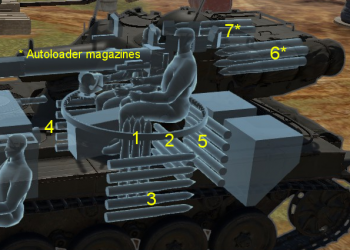
| Full ammo |
1st rack empty |
2nd rack empty |
3rd rack empty |
4th rack empty |
5th rack empty |
6th rack empty |
7th rack empty |
Visual discrepancy |
|---|---|---|---|---|---|---|---|---|
| 36 | 32 (+4) | 28 (+8) | 23 (+13) | 18 (+18) | 13 (+23) | 7 (+29) | 1 (+35) | No |
Notes:
- Shells are modeled individually and disappear after having been shot or loaded.
- Rack 6* and 7* (autoloader magazines) are first stage ammo racks. They total 12 shells.
- These racks get filled first when loading up the tank and are also emptied first.
- As the AMX-13 (SS.11) is equipped with an autoloader, manual reloading of the gun is not possible.
- Once the autoloader magazines have been depleted, you can't shoot until the loader has restocked the autoloader. The restocking time is longer than the normal reload time of the gun (about 15 seconds). Take this into account when playing.
- Simply not firing when the gun is loaded will move ammo from racks 1 to 5 into rack 7* then 6*. Firing will interrupt the restocking of the ready racks.
- The depletion order at full capacity is: 6* - 7* - 1 - 2 up to 5.
Additional armament
| SS.11 ATGM | ||||
|---|---|---|---|---|
| Capacity | Vertical | Horizontal | Stabilizer | |
| 4 | N/A | N/A | N/A | |
Ammunition
| Penetration statistics | |||||||
|---|---|---|---|---|---|---|---|
| Ammunition | Type of warhead |
Penetration @ 0° Angle of Attack (mm) | |||||
| 10 m | 100 m | 500 m | 1,000 m | 1,500 m | 2,000 m | ||
| LFK SS.11 | ATGM | 600 | 600 | 600 | 600 | 600 | 600 |
| Missile details | ||||||||||||
|---|---|---|---|---|---|---|---|---|---|---|---|---|
| Ammunition | Type of warhead |
Velocity (m/s) |
Range (m) |
Projectile mass (kg) |
Fuse delay (m) |
Fuse sensitivity (mm) |
Explosive mass (TNT equivalent) (kg) |
Ricochet | ||||
| 0% | 50% | 100% | ||||||||||
| LFK SS.11 | ATGM | 220 | 3,500 | 29.99 | 0.05 | 0.1 | 2 | 80° | 82° | 90° | ||
Ammo racks
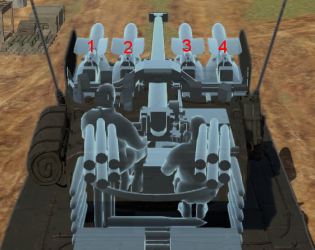
| Full ammo |
Visual discrepancy |
|---|---|
| 4 | No |
Notes:
- The missiles are listed from 1 to 4.
- It is not possible to select how many missiles to bring into battle.
Machine guns
| 7.5 mm MAC 31 | ||||
|---|---|---|---|---|
| Mount | Capacity (Belt) | Fire rate | Vertical | Horizontal |
| Coaxial | 4,950 (150) | 551 | N/A | N/A |
Usage in battles
The AMX-13 is a flanker. This combined with the SS.11 ATGMs on board gives the ability to do two different styles. Either to zoom around (shoot'n'scoot) or stand far back and send missiles flying towards the enemies. In RB though, the missiles are controlled by WASD, making aiming a little bit more difficult. Furthermore, avoid getting shot at all cost. The armour might save you from 0.50 cals, but 14.5 mm and larger will destroy the vehicle in its entirety. Flanking is a viable option, done in the same way as M18, without the penetration needed for frontal armour.
The AMX-13 (SS.11) is exceptionally fast and agile, but sacrifices armour to achieve this. Due to this, it's best to use this tank as either a hit-and-fade flanker or as a standoff sniper, especially with the SS.11 ATGMs onboard.
Try to get around areas that enemy tanks would not typically expect a light tank to be and wait in ambush position for enemy tanks to pass through. Due to being able to get a shot at the sides, the cannon should be used for the first shot, and especially so due to the auto-loading system able to load in rounds in about six seconds. Utilize the SS.11 missiles during these reload times to ensure that the enemy target is annihilated.
As a stand off sniper, don't be anywhere too near the front line where allies and enemies are duking it out. Try to stay around the corner, only peeking out a bit only to hit at an enemy not paying attention with the 75 mm cannon, or precision targeting with the SS.11 missiles. Take care not to hit any allies when firing the missiles from a distance.
Pros and cons
Pros:
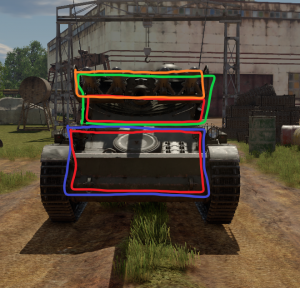
- Main cannon autoloader with 12 shots ready to go
- Nice cannon that will penetrate sides of other vehicles
- A total of four (4) SS.11 Missiles ready to go
- SS.11 penetrates 600 mm of 90 degrees RHA at any range
- SS.11 has a rather small guidance dead zone of about 200 m compared to other missiles (RB/SB)
- For once, oscillating turret of AMX-13 is not only a downside, as it allows to fire SS.11 over cover (mostly useful in AB)
- AMX-13 low profile allows for easier concealability among terrain
- Mobile enough to flank
- Has great acceleration to get up to speed
- Has a lot of smoke dischargers, which cover a lot of terrain in one go
Cons:
- Cannon may not be reliable enough to penetrate vehicles from the front at this rank
- After the autoloader is emptied, gun will not reload until it is rearmed, which takes a long time
- SS.11 still has a guidance dead zone, which means, in very close combat you have to aim in between the tank and opponent to hit the target, or it will just fly over them
- Missiles are aimed with WASD movement keys, tank must be stopped when guiding missile to target (RB/SB)
- Missile racks cover up a portion of the sight from the tank gunner's perspective
- Non-existent armour, but will protect against the .50 cal M2 frontally. Anywhere else it goes right through
- Aerial strafing may penetrate through the roof armour
- HESH (High Explosive Squash Head) and HE obliterates this vehicle
- SPAA can and will obliterate the AMX-13
- Three crew members in a cramped tank means an inability to take a loss without dip in combat efficiency or outright destruction
- Top speed is rather poor for a light tank
- Smoke dischargers fire all at once, player will have to make the most of that one screen
History
AMX-13
Development
Development of the AMX-13 began in 1946 in response to a requirement by the French Army for a light tank to support paratroopers. It was designed at Atelier de Construction d'Issy-les-Moulineaux (AMX). A long line of prototypes lead to the production model. The first prototype was the AMX-13 2A in 1948, with four road wheels. Next came the 2B with five road wheels and a raised idler wheel, and the 2C with the FL-10 turret and two return rollers. The 2D introduced an arrangement with four return rollers.
Design
The turret held the commander and gunner, and was set to the rear of the vehicle. The hull was very compact and low profile, with the engine on the right side and the driver in the front, left side.
The main feature of the AMX-13 was the FL-10 oscillating turret, armed with a 75 mm gun with an automatic loader system fed by two six-round magazines, for a total of 12 rounds in the autoloading mechanism. The gun could depress 8° and elevate 12°, with 5° per second of elevation speed. The turret could rotate 360° with 30° per second of traverse speed. A TCV 107 laser rangefinder was provided to the gunner. 6 smoke grenade launchers were fitted on the turret, with 6 more grenades stored in the vehicle. One coaxial 7.62 mm machine gun was fitted, with 1,800 rounds in belts of 200. Another 7.62 mm machine gun could be fitted on an anti-aircraft mount with 1,800 rounds.
The gasoline engine produced 250 horsepower, and the manual transmission had five forward and one reverse gear. The suspension was of the torsion bar type. The drive sprockets were in the front, return rollers in the back, and there were five road wheels and four return rollers. The AMX-13 could reach a speed of 60 km/h, and it had a range of 400 km.
The protection of the AMX-13, it being a light tank, was not great. It could withstand heavy machine gun and low-calibre autocannon rounds from the front, but the sides could not even withstand heavy machine gun fire. An appliqué armour package was developed to increase protection at the choice of the user.
Production
Production began in 1952, at Atelier de Construction Roanne (ARE). Over 7,000 AMX-13s of all variants were produced, seeing export to a number of nations as well as seeing service with the French Army. Production shifted to Creusot-Loire at Chalon-sur-Saône in 1964, since ARE began producing the AMX-30 in that year.
Service
The French Army received most of the original 75 mm-armed version, with about 3,000 entering service. They were assigned to the regular armoured units, which were mostly filled with M47 and M48 Patton medium tanks at the time. AMX-13 squadrons had four tanks, and were split into two sections of one infantry section and one light tank section each, along with an ammunition truck and command vehicle. These squadrons were used for screening and reconnaissance, locating enemy forces and engaging them. After the first section had engaged the enemy and was reloading, the second section engaged the enemy. The process of alternating reloading and firing between the sections allowed the tanks to hold off the enemy until medium tanks arrived.
In the 1960's, the AMX-30 entered service. AMX-13s were used during the decolonization war in Algeria (1954-1962), although they saw little combat due to the lack of opposition and the terrain. After the French AMX-13s were up-gunned with the 90 mm gun, they often saw service in foreign theatres of operation due to their relative inexpensiveness. The AMX-13s were decommissioned and put into reserve starting in 1985.
AMX-13 (SS.11)
The AMX-13 (SS.11), also known as the AMX-13 T75, was a version of the AMX-13 that was armed with four SS.11 wire-guided anti-tank guided missiles (ATGMs).
Devblog
Initial development of the AMX-13 began after WW2 ended. In 1946, the French army needed a new fighting vehicle to support paratrooper units. This new vehicle needed to be fast and lightweight with a maximum weight of 13 tons. The contract was awarded to the state-owned Atelier de Construction d'Issy-les-Moulineaux (AMX) company, which was located close to Paris. AMX was able to quickly design the new vehicle and build the first prototypes in just 3 years. After successfully blazing through initial trials, AMX started producing the AMX-13 in the early 1950s. Production continued well into the 1980s as the aging AMX-13 was continually modernized, modified, and upgraded. The AMX-13 SS.11 is a modernized version of the AMX-13 developed during the Cold War. By 1962, the AMX-13's standard 75 mm cannon had become less effective against the armour of contemporary tanks, some of which had begun using composite armour.
In 1962, the French military high command approved modernization work for the AMX-13 to upgrade and increase the AMX-13's firepower. However, while increasing firepower was the primary goal, the French high command didn't want to exceed the AMX-13's weight. This limited options and ruled out major upgrades, so the engineers decided to mount four SS.11 first generation ATGM launchers to the front of the turret. The changes were incremental but achieved the desired effect. Thanks to the ATGMs, the AMX-13 could now effectively engage targets up to 3 km away and penetrate up to 600 mm of steel armour—something previously impossible for the 75 mm cannon alone. The AMX-13 SS.11 joined the ranks of the French army in the 1960s and continued to serve for well over two decades.
Media
- Skins
- Videos
See also
Links to the articles on the War Thunder Wiki that you think will be useful for the reader, for example:
- reference to the series of the vehicles;
- links to approximate analogues of other nations and research trees.
External links
| Ateliers de construction d'Issy-les-Moulineaux (AMX) | |
|---|---|
| Light tanks | |
| AMX-13 | AMX-13-M24 · AMX-13 (FL11) · AMX-13 · AMX-13 (SS.11) · AMX-13-90 · AMX-13 (HOT) |
| Armoured cars | AMX-10RC |
| Medium tanks | AMX M4 · AMX-50 (TOA100) |
| MBTs | |
| AMX-30 | AMX-30 · AMX-30 ACRA · AMX-30 (1972) · AMX-30B2 · AMX-30B2 BRENUS · AMX-30 Super |
| AMX-32/40 | AMX-32 (105) · AMX-32 · AMX-40 |
| Heavy tanks | AMX-50 Surbaissé · AMX-50 Surblindé |
| Tank destroyers | ELC bis · AMX-50 Foch |
| SPAAGs | AMX-13 DCA 40 · AMX-30 DCA |
| Export | AMX-13 |
| France light tanks | |
|---|---|
| AMC.34/35 | AMC.34 YR · AMC.35 (ACG.1) |
| H.35/39 | H.35 · H.39 · H.39 "Cambronne" |
| AMX-13 | AMX-13 (FL11) · AMX-13-M24 · AMX-13 · AMX-13 (SS.11) · AMX-13-90 · AMX-13 (HOT) |
| Wheeled | AML-90 · AMX-10RC · Vextra 105 |
| AMD.35 | AMD.35 · AMD.35 (SA35) |
| E.B.R. | E.B.R. (1951) · E.B.R. (1954) · E.B.R. (1963) |
| Other | FCM.36 · R.35 (SA38) · Char 25t · MARS 15 · VBCI-2 (MCT30) |
| Austria | SK-105A2 |
| Great Britain | ▄Crusader Mk.II |
| USA | LVT-4/40 · ▄M3A3 Stuart |
| France premium ground vehicles | |
|---|---|
| Light tanks | AMD.35 (SA35) · H.39 "Cambronne" · LVT-4/40 · AMX-13 (SS.11) · AMX-13-M24 · E.B.R. (1954) · E.B.R. (1963) · VBCI-2 (MCT30) |
| Medium tanks | M4A1 (FL10) · Panther "Dauphiné" · AMX-30 · AMX-30 Super · AMX-50 (TO90/930) |
| Heavy tanks | B1 ter · 2C bis · Somua SM |
| Tank destroyers | Lorraine 155 Mle.50 |


